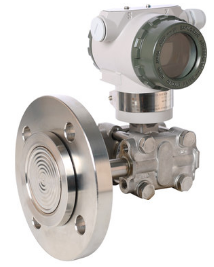Differential Pressure Level Measurement: Choosing Between
Single and Double Flange Transmitters
When it comes to measuring fluid levels in industrial tanks—especially those containing viscous, corrosive, or crystallizing media—differential pressure level transmitters are a trusted solution. Depending on the tank design and pressure conditions, two main configurations are used: single-flange and double-flange transmitters.
When to Use Single-Flange Transmitters
Single-flange transmitters are ideal for open or lightly sealed tanks. They measure hydrostatic pressure from the liquid column, converting it to level based on the known fluid density. The transmitter is installed at the bottom of the tank, with the low-pressure port vented to atmosphere.
Example: Tank height = 3175 mm, water (density = 1 g/cm³)
Pressure range ≈ 6.23 to 37.37 kPa
To ensure accurate readings, it’s important to configure zero elevation correctly when the minimum liquid level is above the transmitter tap.
When to Use Double-Flange Transmitters
Double-flange transmitters are designed for sealed or pressurized tanks. Both the high- and low-pressure sides are connected via remote diaphragm seals and capillaries.
There are two setups:
- Dry leg: For non-condensing vapors
- Wet leg: For condensing vapors, requiring pre-filled sealing fluid in the low-pressure line
Example: 2450 mm liquid level, 3800 mm capillary fill height
Range may be –31.04 to –6.13 kPa
In wet leg systems, negative zero suppression is necessary.
Installation Best Practices
- • For open tanks, always vent the L port to atmosphere
- • For sealed tanks, reference pressure or wet legs must be configured based on vapor behavior
- • Keep capillaries bundled and fixed to minimize environmental effects
- • The transmitter should be installed 600 mm below the high-pressure diaphragm to apply stable head pressure
- • Avoid mounting above the seal unless specifically calculated
Differential pressure transmitters with flange designs offer high accuracy and reliability in chemical plants, power systems, and environmental units. Choosing the right configuration ensures safety, process efficiency, and long-term stability in harsh industrial conditions.
Engineering Support
Consult our measurement specialists for application-specific solutions:
Post time: May-19-2025






